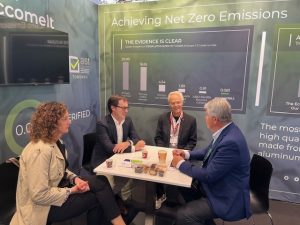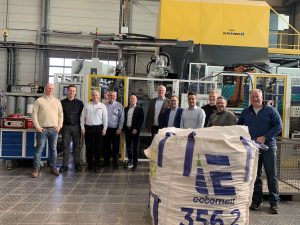Read Below for the article as published in CASTING SOURCE!
MINIMIZING THE CARBON FOOTPRINT OF A356 CASTINGS
Martin Hartlieb and Greg Wittbecker
November 16, 2021
In order to meet sustainability and circular economy targets—in particular emission reduction—demanded by legislation and society, companies are increasingly required to calculate (and minimize) their carbon footprint and that of their products. Foundries are not an exception. For example, in December 2020, Ronal Group announced its first “carbon neutral recycled wheels.”
For A356 castings, the biggest source of CO2 by far comes from the metal, especially the primary metal. According to the International Aluminum Institute (IAI), its global average carbon footprint is 16.8t CO2e/t Al, but big variations exist. Using low-carbon footprint A356.2 ingots or high-quality recycled metal (usually under 2, but in the best case below 0.4t CO2e/t Al) is key, and so is internal recycling of all runaround scrap. The product carbon footprint caused by the foundry’s processes (melting, casting, heat treatment, etc.) is usually only around 0.4-0.8t CO2e /t Al casting, making up from 3%-15% of a casting’s total product carbon footprint. This is mainly driven by the melting step, which often represents more than half of a foundry’s energy consumption and therefore also carbon footprint.
Minimizing energy consumption, using low-carbon energy sources (especially electricity from renewable energy), practicing the highest efficiency in all process steps, and recycling/reusing all waste products are a must, but maximizing recycling content in the aluminum cast remains the most efficient way to minimize the carbon footprint of A356 (and many other) castings.
When comparing different carbon footprints of different aluminum producers and their metal, it is important to verify their numbers are comparable (i.e. used the same methods/standards and boundaries).
The most common standard used to quantify carbon footprint is the Greenhouse Gas Corporate Accounting and Reporting Standard (GHG Protocol Corporate Standard), which is the basis for ISO 14064. It defines three scopes: Scope 1 includes direct emissions of the company, Scope 2 covers indirect emissions from purchased energy, and Scope 3 looks at all indirect emissions from the entire value chain including raw materials (this is the most difficult part to calculate for most producers of metal and castings).
Many primary aluminum producers use the IAI standard, which has three levels: Level 1 covers emissions from aluminum electrolysis, ingot casting and anode production, and from electricity production (so basically Scope 1 and 2 from the GHG Protocol Corporate Standard). Currently, this is often used to measure and compare primary aluminum ingots and define “low carbon aluminum,” which is missing very important elements only captured in Levels 2 and 3. Level 2 covers direct emissions from bauxite mining and alumina refining, electricity, heat production and fuel combustion from those processes. Level 3 represents the complete cradle-to-gate carbon footprint of primary aluminum ingots, including all raw material transports, electricity, heat generation and dross processing. It also includes all ancillary materials and fuels required. The transport portions can be long, as the value chain is often far dispersed.
When it comes to the carbon footprint of primary aluminum (and especially A356.2), huge variations can occur, and they can be from under 4 to over 20t CO2e/t Al—mainly depending on the energy sources and technologies used. Bauxite mining represents a small portion of the total carbon footprint of primary aluminum, but alumina refining can be anywhere between 0.4 to 6.8t CO2e/t Al with a global average of 1.2t CO2e/t alumina. It takes about 2 tons of alumina to produce 1 ton of aluminum. Anode and paste production, as well as ingot casting, also contribute, but the main contribution comes from the electrolysis in the smelter. Figure 1 shows the global average numbers from the IAI, which estimates the current global average primary aluminum to have 16.8t CO2e/ t Al (cradle-to-gate).
Traceability through often long, dispersed and changing value chains can be very challenging, which is why most primary producers will only publish Level 1 or Scope 1 and 2 emissions. Without getting full Level 3/Scope 1-3 numbers, those publications are useful for comparing primary smelters but for a foundry they are not only worthless—they can also be misleading. Some producers, like Rio Tinto, have started tackling this problem by certifying traceability through its value chain and giving a full carbon footprint of its ingots to interested customers.
The IAI is also showing the impact of different primary aluminum cradle-to-gate emissions intensity with different power mixes (Fig. 2).
CRU International (London) has developed a proprietary model to measure emissions and the carbon intensity of global primary aluminium production. This model tracks Scopes 1 and 2 emissions.
Presently, the model covers 274 assets. The average weighted carbon intensity is 10.64 tons of CO2e per ton of production. As expected, the range of carbon intensity is extreme, with the lowest intensity being 1.57 tons and the highest at 19.7 tons. This range of carbon intensity is plotted in Figure 3. Figure 4 provides perspective on how this carbon intensity looks by country.
Naturally, energy source directly impacts carbon intensity, with hydro-based production delivering extremely low carbon intensity. Conversely, those smelters deriving their energy from coal are positioned highest on the carbon curve.
Low carbon production is generally considered to be 4 tons CO2e/ton of production. CRU’s model for 2020 shows about 16.2 million metric tons conform to this standard and represents the first quartile of the “carbon intensity curve.” Second quartile carbon intensity ranges from 4.01 to 13.5 tons of CO2e. The third quartile ranges from 13.66 tons of CO2e to 16.73. Fourth quartile producers have intensities ranging from 16.75 to the top end of 19.72 tons.
Currently, several primary aluminum producers are working to leverage their low carbon profiles. They are coming up with special “low carbon primary aluminum” brands like “RenewAl” (Rio Tinto), “Allow” (Rusal), “Ecolum” (Alcoa), or “Reduxa” (Hydro), and some are even certifying a consistent value chain from the bauxite mine to the smelter/cast house (e.g. Rio Tinto’s START initiative). Some companies are working on new technologies (e.g. inert anodes) that will further reduce the carbon footprint of primary aluminum, such as Elysis—a joint venture between Rio Tinto and Alcoa. However, the industry is still far away from large volume production on a global scale, and available low carbon primary aluminum options have growing premiums. Some other producers, like Hydro with “CIRCAL” or Alcoa with “EcoDura,” are integrating recycled content into primary aluminum to reduce the carbon footprint.
Recycled aluminum is said to use only 5% of the energy of primary, and the Aluminum Association calculated its carbon footprint cradle-to-gate at 0.673t CO2e/t Al, a level that will not be reachable with primary aluminum any time soon. The big push now is to increase recycling to improve sorting and to maximize recycling content. Post-consumer scrap is considered to be reset to zero carbon footprint, while pre-consumer scrap is considered to conserve its original carbon footprint. Making A356.2 (0.12% Fe max) is normally not possible from 100% recycled metal, but if a foundry can accept, at least for a portion of their metal, 0.15% Fe max, then a significant recycling content is possible. A European secondary alloy producer (Raffmetal), for example, publishes exactly this—A356.1 (0.15% Fe max) with 80% recycled content (“SILVAL”) having a carbon footprint of 1.89t CO2e/t Al.
The main driver for carbon footprint in recycled aluminum is the melting step and metal loss (especially due to dirty scrap). Eccomelt LLC developed a nonthermal recycling process for A356 post consumer scrap wheels. Its product, “eccomelt356.2” with 0.15% Fe max has a carbon footprint cradle-to-gate of 0.136t CO2/t Al (0.112 if shipped loose without bags).
Transportation of both incoming material, as well as castings to customers, also contributes to a casting’s carbon footprint, and logistics therefore need to be optimized (e.g. maximize train or sea transport over trucks). Calculating this portion is easy to do with freely accessible web-services like www.ecotransit.org.
A356 foundries are increasingly optimizing their metal mix with the objective to maximize recycling content in order to minimize their carbon footprint. Internal recycling is of course a must, as is furnace efficiency optimization, and when possible, switching to renewable energy sources (e.g. electric furnaces). Together with maximum external recycling content, the pressure is on best practices for melting and melt treatment. With the right technologies and know-how, a foundry can manage this very well and reduce its carbon footprint and that of its castings by a significant percentage at reasonable costs (or even with a cost saving, as recycled metal can be considerably cheaper than primary metal).
For example, if you made a casting from 100% “global average” primary A356.2 ingots with a 70% process yield and no internal recycling, those castings would have a carbon footprint of 24.29t CO2e/t Al. By recycling internally (and therefore replacing 30% of the primary ingots), the carbon footprint drops by about a quarter to 17.14t CO2e/t Al. By now, replacing 20% of the primary ingots with eccomelt356.2, the carbon footprint drops to half of the original value, only 12.4t CO2e/t Al casting. If low carbon primary A356.2 ingots are used, the values are much lower, but the carbon footprint reduction by internal recycling and using eccomelt356.2 to replace primary ingots have the same effect of cutting the casting’s carbon footprint in half.
In addition to lowering the carbon footprint per se, recycling content in a furnace can help foundries increase the charge density and therefore the melting efficiency, which additionally contributes to lowering the carbon footprint of the castings.
Foundries are increasingly asked to calculate and reduce the carbon footprint of their castings. The contributions of a foundry with melting, casting, heat treating, machining, etc. are very small compared to the carbon footprint of the purchased metal used for making the castings. Primary ingots can have a carbon footprint of up to 20t CO2e/t Al, and even “low carbon primary” A356 ingots are around 4t CO2e/t Al. Recycling is therefore very important, as it reduces the amount of primary metal with a much lower carbon footprint material.
For the Full Article with Visuals click :
https://www.castingsource.com/articles/2021/11/16/minimizing-carbon-footprint-a356-castings





